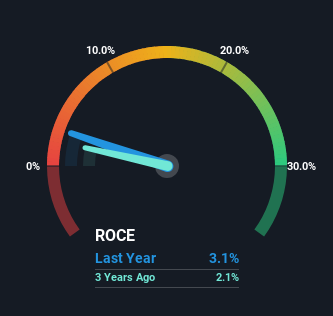What trends should we look for it we want to identify stocks that can multiply in value over the long term? Ideally, a business will show two trends; firstly a growing return on capital employed (ROCE) and secondly, an increasing amount of capital employed. If you see this, it typically means it's a company with a great business model and plenty of profitable reinvestment opportunities. However, after investigating Gelsenwasser (FRA:WWG), we don't think it's current trends fit the mold of a multi-bagger.
Return On Capital Employed (ROCE): What Is It?
For those that aren't sure what ROCE is, it measures the amount of pre-tax profits a company can generate from the capital employed in its business. The formula for this calculation on Gelsenwasser is:
Return on Capital Employed = Earnings Before Interest and Tax (EBIT) ÷ (Total Assets - Current Liabilities)
0.031 = €67m ÷ (€3.3b - €1.2b) (Based on the trailing twelve months to June 2024).
Thus, Gelsenwasser has an ROCE of 3.1%. Ultimately, that's a low return and it under-performs the Integrated Utilities industry average of 6.4%.
Check out our latest analysis for Gelsenwasser

Historical performance is a great place to start when researching a stock so above you can see the gauge for Gelsenwasser's ROCE against it's prior returns. If you want to delve into the historical earnings , check out these free graphs detailing revenue and cash flow performance of Gelsenwasser.
How Are Returns Trending?
When we looked at the ROCE trend at Gelsenwasser, we didn't gain much confidence. Over the last five years, returns on capital have decreased to 3.1% from 4.2% five years ago. Given the business is employing more capital while revenue has slipped, this is a bit concerning. If this were to continue, you might be looking at a company that is trying to reinvest for growth but is actually losing market share since sales haven't increased.
While on the subject, we noticed that the ratio of current liabilities to total assets has risen to 36%, which has impacted the ROCE. Without this increase, it's likely that ROCE would be even lower than 3.1%. While the ratio isn't currently too high, it's worth keeping an eye on this because if it gets particularly high, the business could then face some new elements of risk.
The Bottom Line On Gelsenwasser's ROCE
We're a bit apprehensive about Gelsenwasser because despite more capital being deployed in the business, returns on that capital and sales have both fallen. It should come as no surprise then that the stock has fallen 36% over the last five years, so it looks like investors are recognizing these changes. With underlying trends that aren't great in these areas, we'd consider looking elsewhere.
If you want to continue researching Gelsenwasser, you might be interested to know about the 1 warning sign that our analysis has discovered.
While Gelsenwasser may not currently earn the highest returns, we've compiled a list of companies that currently earn more than 25% return on equity. Check out this free list here.
New: Manage All Your Stock Portfolios in One Place
We've created the ultimate portfolio companion for stock investors, and it's free.
• Connect an unlimited number of Portfolios and see your total in one currency
• Be alerted to new Warning Signs or Risks via email or mobile
• Track the Fair Value of your stocks
Have feedback on this article? Concerned about the content? Get in touch with us directly. Alternatively, email editorial-team (at) simplywallst.com.
This article by Simply Wall St is general in nature. We provide commentary based on historical data and analyst forecasts only using an unbiased methodology and our articles are not intended to be financial advice. It does not constitute a recommendation to buy or sell any stock, and does not take account of your objectives, or your financial situation. We aim to bring you long-term focused analysis driven by fundamental data. Note that our analysis may not factor in the latest price-sensitive company announcements or qualitative material. Simply Wall St has no position in any stocks mentioned.
About DB:WWG
Gelsenwasser
Engages in the water, energy, and service businesses in Germany, the Czech Republic, and Poland.
Mediocre balance sheet second-rate dividend payer.
Similar Companies
Market Insights
Community Narratives



